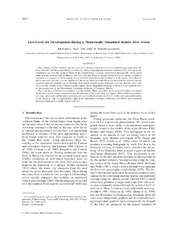| dc.creator | Igau, Richard | |
| dc.creator | Nielsen-Gammon, John | |
| dc.date.accessioned | 2016-10-28T18:47:03Z | |
| dc.date.available | 2016-10-28T18:47:03Z | |
| dc.date.issued | 1998-11-01 | |
| dc.identifier.citation | Igau, R. C., and J. W. Nielsen-Gammon, 1998: Low-level jet development during a numerically simulated return flow event. Mon. Wea. Rev., 126, 2972-2990. | en |
| dc.identifier.uri | https://hdl.handle.net/1969.1/158220 | |
| dc.description | © Copyright 1998 American Meteorological Society (AMS). Permission to use figures, tables, and brief excerpts from this work in scientific and educational works is hereby granted provided that the source is acknowledged. Any use of material in this work that is determined to be “fair use” under Section 107 of the U.S. Copyright Act September 2010 Page 2 or that satisfies the conditions specified in Section 108 of the U.S. Copyright Act (17 USC §108, as revised by P.L. 94-553) does not require the AMS’s permission. Republication, systematic reproduction, posting in electronic form, such as on a web site or in a searchable database, or other uses of this material, except as exempted by the above statement, requires written permission or a license from the AMS. Additional details are provided in the AMS Copyright Policy, available on the AMS Web site located at (https://www.ametsoc.org/) or from the AMS at 617-227-2425 or copyrights@ametsoc.org. | en |
| dc.description.abstract | The evolution of the southerly low-level jet (LLJ) during a return flow event is studied using output from the Penn State/NCAR Mesoscale Model (Version 4). Three geographically different southerly LLJs develop in the simulation: one over the southern Plains of the United States, a second southwest of Brownsville, Texas, and a third over the western Gulf of Mexico. The LLJ over the Plains is found to form first as an inertial oscillation and later as a response to lee troughing and an elevated mixed layer that develops over the region. Over Mexico, the temperature structure over the Altiplanicie Mexicana (Mexican High Plain) is responsible for a locally intense low-level pressure gradient east of the High Plain which remains nearly stationary over two diurnal cycles. The LLJ over the western Gulf of Mexico results largely from topographic blocking of the low-level southerly flow by the eastern end of the Neovolcanic Cordillera northwest of Veracruz, Mexico.
The evolution of the lower troposphere over the southern Plains resembles the Carlson and Ludlam conceptual model for a severe storm environment, but the structure of the return flow is complex. When midlevel westerlies are weak, mesoscale and boundary layer processes govern the development of LLJs. As the west and southwesterly winds increase with an approaching upper-level disturbance, synoptic influences overwhelm the mesoscale processes leading to a single, larger-scale LLJ. | en |
| dc.description.sponsorship | National Oceanic and Atmospheric Administration | en |
| dc.language.iso | en_US | |
| dc.publisher | American Meteorologial Society | |
| dc.title | Low-Level Jet Development during a Numerically Simulated Return Flow Event | en |
| dc.type | Article | en |
| local.department | Atmospheric Sciences | en |
| dc.identifier.doi | 10.1175/1520-0493(1998)126<2972:LLJDDA>2.0.CO;2 | |


